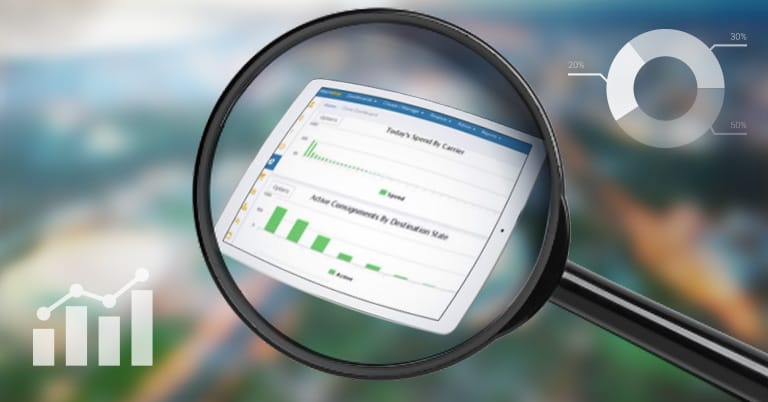When you work in freight management, it’s easy to feel like you’re drowning in numbers. Whether you’re a freight broker (4PL), logistics service provider, or running an eCommerce business, when order volumes creep up and fulfilment rates start to wobble, it doesn’t take long for customers to start looking elsewhere.
They say if you take care of the cents, the dollars look after themselves. The same is true for the one-percenters in freight. So, what freight KPIs are the most important for keeping your costs down, your customers happy, and your business in a position to grow?
These are the top 9 metrics to focus on for better freight success.
CONTENTS
2. Freight Spend with Carriers
3. Customer Net Promoter Score
4. Transit Time
1. Carrier DIFOT
DIFOT refers to ‘delivery in full, on time’. This metric measures the percentage of orders delivered completely, within the agreed time frame. It’s crucial for assessing carrier performance, customer satisfaction, and operational efficiency. High DIFOT rates indicate reliable carriers and a smooth logistics process.
MachShip calculates DIFOT directly, rather than relying on carrier reporting which can be subject to various caveats around why an item couldn’t be delivered. Reporting with transparency and no asterisks means users can see exactly what outcomes their customers are getting.

2. Freight Spend with Carriers
Does what it says on the tin. Freight spend tracks your total expenditure on freight services with different carriers. This helps supply chain managers control costs, negotiate better rates, and allocate budgets effectively.
Monitoring freight spend is essential for cost saving and identifying opportunities for savings. Obviously, being able to see what proportion of total cost base goes towards freight carriers allows businesses to see when those costs are potentially creeping up and eating into margins, as well as which markets are more cost-effective than others.
See MachShip’s carrier integrations.
3. Customer Net Promoter Score
Customer expectations are already high, and increasing all the time. Net promoter score (NPS) is a key metric that has a tendency to be overlooked, especially in the B2B sector.
NPS measures customer satisfaction and loyalty – basically by asking how likely customers are to recommend your business on a scale from 1-10. High NPS scores indicate positive customer experiences and can drive repeat business. Anyone who scores 8-10 is a promoter. Anyone who scores 5-7 is neutral. And anyone who ranks under 5 is a detractor. In the context of logistics, this reflects the end-to-end service quality, including delivery performance.
In the context of logistics, NPS reflects the end-to-end service quality, including delivery performance. Higher NPS scores indicate positive customer experience.
As businesses start to diversify their logistics and supply chain more and more, customer expectations and demand will influence carrier choice more than anything else. Having a real-time view of your customer NPS – even in a B2B environment – will always give businesses a competitive advantage. Not to mention a tangible feather in your cap for potential marketing purposes.
4. Transit Time
Again, pretty self-explanatory. Transit time measures the duration taken for goods to travel from the point of origin to the destination. It’s critical for ensuring timely deliveries, meeting customer expectations, and optimising route planning. Reducing transit time can boost efficiency and customer satisfaction.
From a MachShip perspective, the platform generates reports that can indicate where your carriers can deliver faster than others. This provides users with strong visibility around transit times (which are all kept up to date) to inform carrier selection and enable you to accurately manage customer expectations.
5. Freight Damage Rate
Freight damage rate refers to the percentage of shipments that are damaged during transit. This metric is important for maintaining product quality and customer satisfaction, as well as minimising loss and claims costs.
No prizes for guessing that lowering damage rates is a big help in maintaining brand reputation and reducing costs.

6. Order Accuracy
Order accuracy measures the percentage of orders delivered correctly without errors in quantity or product type. High order accuracy reduces the likelihood of returns and increases customer satisfaction. This metric reflects the effectiveness of warehouse operations and order fulfilment processes.
7. Cost per Shipment
This metric calculates the average cost involved in shipping a single order. Cost per shipment is vital for understanding the efficiency of logistics operations and for benchmarking against industry standards. Naturally, lowering the cost per shipment is a big factor in improving profitability.
Freight profile and geography will ultimately determine the cost of shipments – in other words, what’s being shipped and where it’s going. But these costs can still potentially be optimised based on carrier mix and packing arrangements.
Demystifying Freight Rates: What factors affect your costs?
8. Warehouse Turnover Rate
This measures the frequency with which inventory is cycled through the warehouse during a given time frame.
A high turnover rate indicates efficient inventory management and storage utilisation. This helps in reducing holding costs, while minimising the risk of redundancy and obsolescence.

9. Load Utilisation
Load utilisation measures how effectively the cargo space in transportation vehicles is used. High load utilisation rates indicate efficient use of space, reducing the number of trips required, therefore lowering transportation costs and environmental impact.
Why these metrics matter
Despite all the moving parts and complexity involved in freight management, the desired outcomes remain simple. Getting the right items to the right recipients, intact and on time. Keeping your freight spend as cost-effective as possible without sacrificing service quality and customer satisfaction.
Carrier DIFOT and On-Time Delivery Rate are direct indicators of service reliability and customer satisfaction.
Freight Spend with Carriers and Cost per Shipment help with budget planning and cost control. Customer NPS provides insights into brand loyalty and service quality. Transit Time and Order Accuracy are essential for operational efficiency and meeting customer expectations.
Freight Damage Rate ensures the maintenance of product integrity and reduces wastage.
Warehouse Turnover Rate and Load Utilisation optimise resource use and enhance overall supply chain efficiency.
Want to know how to keep an eye on these metrics using MachShip? Get in touch.

